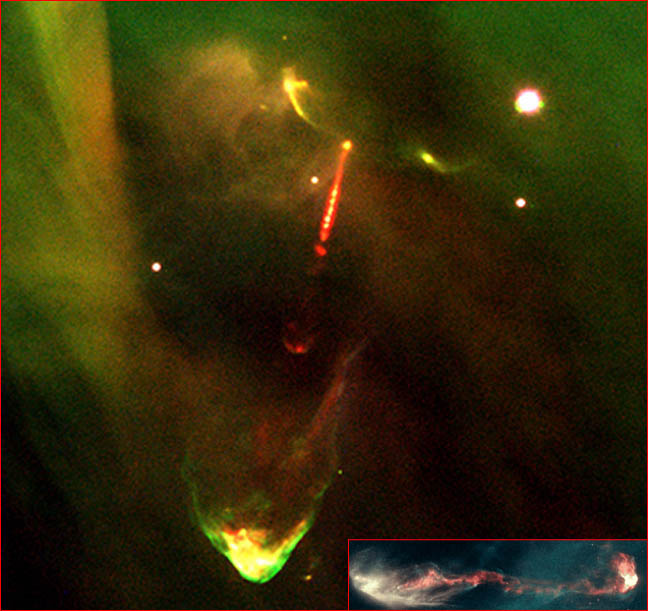
home •
about •
essential guide •
picture of the day •
thunderblogs •
news •
multimedia •
predictions •
products •
get involved •
contact
picture of the day archive subject index
Credit: FORS Team, 8.2-meter VLT, ESO. Inset is another jet, trillions of kilometers long,
showing its corkscrew nature. Credit: HH-47 Star Jet, NASA, HST, WFPC 2, J. Morse
Aug 18, 2006
A Peek at Star FormationProtostar HH-34 lies about 1500 light-years away in the Orion Nebula star-forming region. Some features of HH-34 are understood─some are not. At the core of Herbig-Haro 34 lies a seemingly typical young star. This star, though, somehow ejects energetic "bullets" of high-energy particles.
We see stars. Then we ask questions: What are they? Where do they come from? We can’t get close enough to find direct answers, so we recall things we already know that appear similar or at least relevant.
We’ve had pretty good luck explaining things with gravity and ideal gas laws. Perhaps we could start with an extended cloud of hydrogen (we have to start with something) floating somewhere among the x-, y- and z-axes of a coordinate system. We could let a force act from the center of mass (we know the equations for a point force). We could crank the numbers through the equations and see what happens:
The cloud contracts. The temperature rises. The radiation pressure increases until it balances with the gravitational force from the point. (We must do this slowly in order to maintain equilibrium conditions: Otherwise discontinuities might arise and our continuous equations would no longer be relevant.)
The equations tell us how much the cloud has collapsed and what shape it is and what the temperature is: The cloud has become a sphere the size of a star, and it’s hot enough, provided we assume quantum tunneling effects, at that central point to sustain energy-producing fusion reactions that transform hydrogen into helium. The equations have many variables that can be tuned to match the energy output of stars. The fusion reactions should produce neutrinos: We check and find neutrinos.
Our theory is verified.
But then we keep looking, and we find things that the equations didn’t predict: There are only half as many neutrinos as there should be. And there are magnetic fields, which, as far as we know, are “frozen” into the gaseous cloud and therefore won’t let it contract. We can adjust the equations; we can introduce ad hoc exceptions; we can save the theory.
But after a while all the adjustments and exceptions get cumbersome. Occasionally they even contradict each other. Some of our colleagues begin considering alternative theories. For a time we can keep them in line with threats of refusing grants and denying publication. Then one day we peek at an alternative theory....Instead of a cloud of hydrogen in 3-D coordinates there’s an electric circuit in plasma. Birkeland cables carry power from somewhere to somewhere else: The center of interest is a cosmic power surge through interstellar plasma that evolves through a series of instabilities. The plasma along the current axis pinches into a stack of cells similar to “bead lightning.” The cells become toroidal and then spherical. Long-range electromagnetic forces efficiently pull in matter from the surrounding space and compact it into spheroids. The spiraling force in the Birkeland current sets the spheroids spinning. As the energy dissipates and the current wanes, the spheroids are no longer held by the axial force: They shoot off in random directions.
But they’re still carrying some of the current. If the current increases again, the internal electrical stress explodes them into two or more pieces, which are also spheroidal by virtue of gravity and the electrical pressure on them. If there is a resonance in the circuit, it may show up as an oscillation in a spheroid’s luminosity.
This theory predicts that stars should form along axial filaments that have some helical structure: We observe Herbig-Haro stars (see image above) with long, twisted, knotty “jets” emerging from their poles. This theory predicts that some stars should vary in luminosity with periods that could range from weeks to fractions of a second: We observe variable stars that dim and brighten over a few days to a few hours. We observe pulsars that flash radiation up to thousands of times a second. This theory predicts that many stars should be binary or multiple systems and that many should have close-orbiting gas-giant planets around them: We observe an abundance of multiple star systems and quite a few gas giants in close orbits. This theory predicts no lower size limit to stellar behavior since all bodies receive external electrical power. We observe low mass brown dwarfs flaring and powerfully emitting x-rays.
This theory is verified. We decide to try it, and after a while we forget the first theory.
Then come the personal questions: Will we keep looking? When anomalies are discovered, as they surely will be, how long will we adjust this new theory and make exceptions? How will we treat our colleagues who consider another alternative?
Will we also peek at that novel theory?
___________________________________________________________________________Please visit our Forum
The Electric Sky and The Electric Universe available now!

|
|

|
EXECUTIVE EDITORS:
David Talbott, Wallace Thornhill
MANAGING EDITORS:
Steve Smith, Mel Acheson
CONTRIBUTING EDITORS: Dwardu Cardona, Ev Cochrane,
C.J. Ransom, Don Scott, Rens van der Sluijs, Ian Tresman
WEBMASTER: Brian Talbott
Copyright 2006: thunderbolts.info
![]()
home •
thunderblogs •
forum •
picture of the day •
resources •
team •
updates •
contact us

